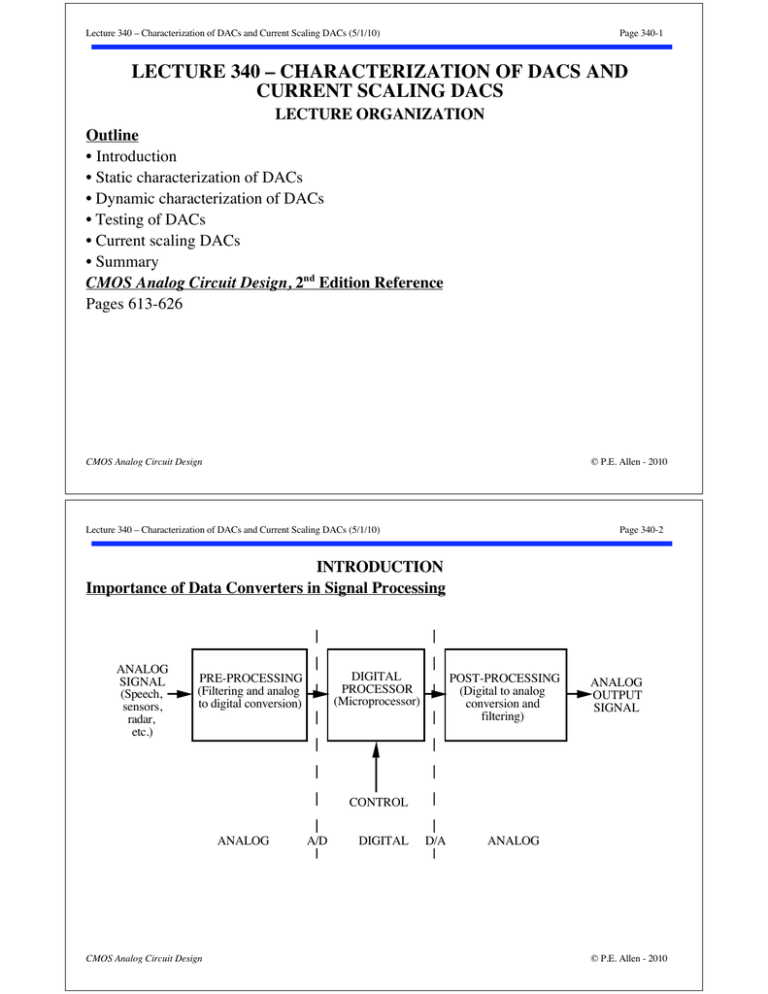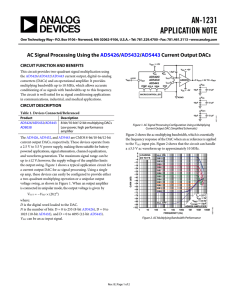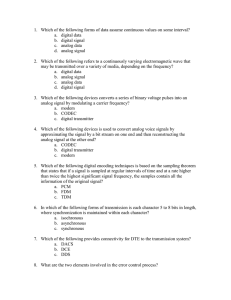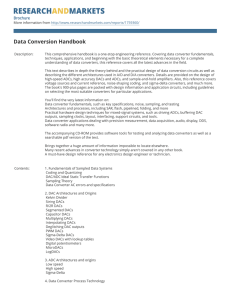Lecture 340 - DACs, Current
advertisement

Lecture 340 – Characterization of DACs and Current Scaling DACs (5/1/10) Page 340-1 LECTURE 340 – CHARACTERIZATION OF DACS AND CURRENT SCALING DACS LECTURE ORGANIZATION Outline • Introduction • Static characterization of DACs • Dynamic characterization of DACs • Testing of DACs • Current scaling DACs • Summary CMOS Analog Circuit Design, 2nd Edition Reference Pages 613-626 CMOS Analog Circuit Design © P.E. Allen - 2010 Lecture 340 – Characterization of DACs and Current Scaling DACs (5/1/10) Page 340-2 INTRODUCTION Importance of Data Converters in Signal Processing ANALOG SIGNAL (Speech, sensors, radar, etc.) DIGITAL PROCESSOR (Microprocessor) PRE-PROCESSING (Filtering and analog to digital conversion) POST-PROCESSING (Digital to analog conversion and filtering) ANALOG OUTPUT SIGNAL CONTROL ANALOG CMOS Analog Circuit Design A/D DIGITAL D/A ANALOG © P.E. Allen - 2010 Lecture 340 – Characterization of DACs and Current Scaling DACs (5/1/10) Page 340-3 Digital-Analog Converters Digital Signal Processing System DIGITALANALOG CONVERTER Microprocessors Compact disks Read only memory Random access memory Digital transmission Disk outputs Digital sensors Filter Reference Analog Output Amplifier Fig. 10.1-01 Characteristics: • Can be asynchronous or synchronous • Primary active element is the op amp • Conversion time can vary from fast (one clock period, T) to slow (2No. of bits*T) CMOS Analog Circuit Design © P.E. Allen - 2010 Lecture 340 – Characterization of DACs and Current Scaling DACs (5/1/10) Page 340-4 Analog-Digital Converters Analog Input 060922-01 Sample and Hold ANALOGDIGITAL CONVERTER Digital Signal Processing System Microprocessors Compact disks Read only memory Random access memory Digital transmission Disk outputs Digital sensors Reference Characteristics: • Can only be synchronous (the analog signal must be sampled and held during conversion) • Primary active element is the comparator • Conversion time can vary from fast (one clock period, T) to slow (2No. of bits*T) CMOS Analog Circuit Design © P.E. Allen - 2010 Lecture 340 – Characterization of DACs and Current Scaling DACs (5/1/10) Page 340-5 STATIC CHARACTERISTICS OF DIGITAL-ANALOG CONVERTERS Block Diagram of a Digital-Analog Converter Voltage Reference VREF DVREF Scaling Network Output Amplifier vOUT = KDVREF Binary Switches b0 b1 b2 Figure 10.1-3 bN-1 b0 is the most significant bit (MSB) The MSB is the bit that has the most (largest) influence on the analog output bN-1 is the least significant bit (LSB) The LSB is the bit that has the least (smallest) influence on the analog output CMOS Analog Circuit Design © P.E. Allen - 2010 Lecture 340 – Characterization of DACs and Current Scaling DACs (5/1/10) Page 340-6 Input-Output Characteristics Ideal input-output characteristics of a 3-bit DAC 1.000 Analog Output Value Normalized to VREF 0.875 0.750 0.625 1 LSB 0.500 Vertical Shifted Characteristic 0.375 0.250 0.125 0.000 000 CMOS Analog Circuit Design Infinite Resolution Characteristic 001 010 011 100 101 Digital Input Code 110 111 Fig. 10.1-4 © P.E. Allen - 2010 Lecture 340 – Characterization of DACs and Current Scaling DACs (5/1/10) Page 340-7 Definitions • Resolution of the DAC is equal to the number of bits in the applied digital input word. • The full scale (FS): FS = Analog output when all bits are 1 - Analog output all bits are 0 V REF 1 FS = (VREF - 2N ) - 0 = VREF1-2N • Full scale range (FSR) is defined as lim (FS) = V FSR = N REF • Quantization Noise is the inherent uncertainty in digitizing an analog value with a finite resolution converter. Quantization Noise 1LSB 0.5LSB 0LSB 000 001 010 011 -0.5LSB 100 101 110 Digital Input 111 Code Fig. 10.1-5 CMOS Analog Circuit Design © P.E. Allen - 2010 Lecture 340 – Characterization of DACs and Current Scaling DACs (5/1/10) Page 340-8 More Definitions • Dynamic Range (DR) of a DAC is the ratio of the FSR to the smallest difference that can be resolved (i.e. an LSB) FSR FSR DR = LSBchange = (FSR/2N) = 2N or in terms of decibels DR(dB) = 6.02N (dB) • Signal-to-noise ratio (SNR) for the DAC is the ratio of the full scale value to the rms value of the quantization noise. T rms(quantization noise) = t 1 LSB FSR LSB2 -0.5 2dt = = T T 12 2N 12 0 vOUT(rms) (FSR/ 122N) • Maximum SNR (SNRmax) for a sinusoid is defined as vOUTmax(rms) FSR/(2 2) 62N SNRmax = = = 2 (FSR/ 122N) FSR/( 122N) or in terms of decibels 62N SNRmax(dB) = 20log10 2 = 10 log10(6)+20 log10(2N)-20 log10(2) = 1.76 + 6.02N dB SNR = CMOS Analog Circuit Design © P.E. Allen - 2010 Lecture 340 – Characterization of DACs and Current Scaling DACs (5/1/10) Page 340-9 Even More Definitions • Effective number of bits (ENOB) can be defined from the above as SNRActual-1.76 ENOB = 6.02 where SNRActual is the actual SNR of the converter. Comment: The DR is the amplitude range necessary to resolve N bits regardless of the amplitude of the output voltage. However, when referenced to a given output analog signal amplitude, the DR required must include 1.76 dB more to account for the presence of quantization noise. Thus, for a 10-bit DAC, the DR is 60.2 dB and for a full-scale, rms output voltage, the signal must be approximately 62 dB above whatever noise floor is present in the output of the DAC. CMOS Analog Circuit Design © P.E. Allen - 2010 Lecture 340 – Characterization of DACs and Current Scaling DACs (5/1/10) Page 340-10 Accuracy Requirements of the i-th Bit • The output of the i-th bit of the converter is expressed as: V REF 2n The output of the i-th bit = 2i+1 2n = 2n-i-1 LSBs • The uncertainty of each bit must be less than ±0.5 LSB (assuming all other bits are ideal. Must use ±0.25 LSB if each bit has a worst case error.) • The accuracy of the i-th bit is equal to the uncertainty divided by the output giving: ±0.5LSB 1 100 Accuracyofthei-thbit=2n-i-1LSB=2n-i= 2n-i % Result: The highest accuracy requirement is always the MSB (i = 0). The LSB bit only needs ±50% accuracy. Example: What is the accuracy requirement for each of the bits of a 10 bit converter? Assuming all other bits are ideal, the accuracy requirement per bit is given below. Bit Number 0 1 2 3 4 5 6 7 Accuracy % 0.098 0.195 0.391 0.781 1.563 3.125 6.25 12.5 (If all other bits are worst case, the numbers above must be divided by 2.) 8 25 9 50 CMOS Analog Circuit Design © P.E. Allen - 2010 Lecture 340 – Characterization of DACs and Current Scaling DACs (5/1/10) Page 340-11 1 7/8 Actual Characteristic 4/8 3/8 2/8 1/8 0 Offset Error 1 Gain Error 6/8 Actual Characteristic 5/8 7/8 6/8 5/8 Analog Output Value Normalized to VREF Analog Output Value Normalized to VREF Offset and Gain Errors An offset error is a constant difference between the actual finite resolution characteristic and the ideal finite resolution characteristic measured at any vertical jump. A gain error is the difference between the slope of the actual finite resolution and the ideal finite resolution characteristic measured at the right-most vertical jump. Infinite Resolution Characteristic Ideal 3-bit Resolution Characteristic 4/8 Infinite Resolution Characteristic 3/8 2/8 Ideal 3-bit Resolution Characteristic 1/8 000 001 010 011 100 101 110 111 Digital Input Code 0 000 001 010 011 100 101 110 111 Digital Input Code Offset Error in a 3-bit DAC Gain Error in a 3-bit DAC Fig. 10.1-6 CMOS Analog Circuit Design © P.E. Allen - 2010 Lecture 340 – Characterization of DACs and Current Scaling DACs (5/1/10) Page 340-12 Analog Output Voltage Integral and Differential Nonlinearity • Integral Nonlinearity (INL) is the maximum difference between the actual finite resolution characteristic and the ideal finite resolution characteristic measured vertically (% or LSB). • Differential Nonlinearity (DNL) is a measure of the separation between adjacent levels measured at each vertical jump (% or LSB). V V cx-V s cx DNL = Vcx – V s = V s Vs = V s -1 LSBs where Vcx is the actual voltage change on a bit-to-bit basis and Vs is the ideal LSB 8 change of (VFSR/2N) 8 Infinite Resolution Characteristic 7 Example of a 3-bit DAC: 8 CMOS Analog Circuit Design 6 8 5 8 4 8 3 8 2 8 1 8 0 8 000 +1.5 LSB DNL Nonmonotonicity +1.5 LSB INL -1 LSB INL A -1.5 LSB DNL Ideal 3-bit Characteristic Actual 3-bit Characteristic 001 010 011 100 101 Digital Input Code 110 111 Fig. 10.1-7 © P.E. Allen - 2010 Lecture 340 – Characterization of DACs and Current Scaling DACs (5/1/10) Page 340-13 Example of INL and DNL of a Nonideal 4-Bit Dac Find the ±INL and ±DNL for the 4-bit DAC shown. 15/16 14/16 Analog Output (Normalized to Full Scale) 13.16 12/16 -2 LSB DNL 11/16 -1.5 LSB INL Ideal 4-bit DAC Characteristic 10/16 9/16 +1.5 LSB DNL 8/16 -2 LSB DNL 7/16 6/16 +1.5 LSB INL Actual 4-bit DAC Characteristic 5/16 4/16 3/16 2/16 1/16 0/16 b0 b1 b2 b3 0 0 0 0 0 0 0 1 0 0 1 0 0 0 1 1 0 1 0 0 0 0 0 1 1 1 1 1 0 0 0 1 1 0 0 1 0 1 0 1 Digital Input Code CMOS Analog Circuit Design Lecture 340 – Characterization of DACs and Current Scaling DACs (5/1/10) 1 0 1 0 1 0 1 1 1 1 0 0 1 1 0 1 1 1 1 0 1 1 1 1 Fig. 10.1-8 © P.E. Allen - 2010 Page 340-14 DYNAMIC CHARACTERISTICS OF DIGITAL-ANALOG CONVERTERS Dynamic characteristics include the influence of time. Definitions • Conversion speed is the time it takes for the DAC to provide an analog output when the digital input word is changed. Factor that influence the conversion speed: Parasitic capacitors (would like all nodes to be low impedance) Op amp gainbandwidth Op amp slew rate • Gain error of an op amp is the difference between the desired and actual output voltage of the op amp (can have both a static and dynamic influence) LoopGain Actual Gain = Ideal Gain x 1+LoopGain IdealGain-ActualGain 1 Gain error = = 1+LoopGain IdealGain CMOS Analog Circuit Design © P.E. Allen - 2010 Lecture 340 – Characterization of DACs and Current Scaling DACs (5/1/10) Page 340-15 Example of Influence of Op Amp Gain Error on DAC Performance Assume that a DAC using an op amp in the inverting configuration with C1 = C2 and Avd(0) = 1000. Find the largest resolution of the DAC if VREF is 1V and assuming worst case conditions. Solution C2 The loop gain of the inverting configuration is LG = C +C Avd(0) = 0.51000 = 500. 2 1 The gain error is therefore 1/501 0.002. The gain error should be less than the quantization noise of ±0.5LSB which is expressed as V REF 1 Gain error = 501 0.002 2N+1 Therefore the largest value of N that satisfies this equation is N = 7. CMOS Analog Circuit Design © P.E. Allen - 2010 Lecture 340 – Characterization of DACs and Current Scaling DACs (5/1/10) Page 340-16 Influence of the Op Amp Gainbandwidth Single-pole response: vout(t) = ACL[1 - e-Ht]vin(t) where ACL = closed-loop gain R1 C2 H = GB R +R or GB C +C 1 2 1 2 To avoid errors in DACs (and ADCs), vout(t) must be within ±0.5LSB of the final value by the end of the conversion time. Multiple-pole response: Typically the response is underdamped like the following (see Appendix C of text). vOUT(t) Upper Tolerance Final Value + ε vIN + vOUT ε Final Value ε Final Value - ε Lower Tolerance Settling Time 0 CMOS Analog Circuit Design 0 Ts t Fig. 6.1-7 © P.E. Allen - 2010 Lecture 340 – Characterization of DACs and Current Scaling DACs (5/1/10) Page 340-17 Example of the Influence of GB and Settling Time on DAC Performance Assume that a DAC uses a switched capacitor noninverting amplifier with C1 = C2 using an op amp with a dominant pole and GB = 1MHz. Find the conversion time of an 8bit DAC if VREF is 1V. Solution From the results in Sections 9.2 and 9.3 of the text, we know that C 2 H = C +C GB = (2)(0.5)(106) = 3.141x106 1 2 and ACL = 1. Assume that the ideal output is equal to VREF. Therefore the value of the output voltage which is 0.5LSB of VREF is 1 1 - 2N+1 = 1 - e-H T or 2N+1 = eH T Solving for T gives 9 N+1 N+1 T = H ln(2) = 0.693 H = 3.141 0.693 = 1.986μs CMOS Analog Circuit Design © P.E. Allen - 2010 Lecture 340 – Characterization of DACs and Current Scaling DACs (5/1/10) Page 340-18 TESTING OF DACs Input-Output Test Test setup: Digital Word Input (N+2 bits) N-bit DAC under test ADC ADC with Output Digital Vout more resolution Subtractor than DAC (N+2 bits) (N+2 bits) Digital Error Output (N+2 bits) Fig. 10.1-9 Comments: Sweep the digital input word from 000...0 to 111...1. The ADC should have more resolution by at least 2 bits and be more accurate than the errors of the DAC INL will show up in the output as the presence of 1’s in any bit. If there is a 1 in the Nth bit, the INL is greater than ±0.5LSB DNL will show up as a change between each successive digital error output. The bits which are greater than N in the digital error output can be used to resolve the errors to less than ±0.5LSB CMOS Analog Circuit Design © P.E. Allen - 2010 Lecture 340 – Characterization of DACs and Current Scaling DACs (5/1/10) Spectral Test Test setup: Page 340-19 1 0 0 0 1 0 0 0 1 0 0 1 0 1 1 1 |Vout(jω)| Vout 1 1 1 1 t Noise floor due to nonlinearities VREF ω Comments: fsig Digital input pattern is selected to Digital N-bit V have a fundamental frequency which out Distortion Pattern Spectral DAC has a magnitude of at least 6N dB Analyzer Generator Output under above its harmonics. (N bits) test Length of the digital sequence Fig. 10.1-10 determines the spectral purity of the Clock fundamental frequency. All nonlinearities of the DAC (i.e. INL and DNL) will cause harmonics of the fundamental frequency The THD can be used to determine the SNR dB range between the magnitude of the fundamental and the THD. This SNR should be at least 6N dB to have an INL of less than ±0.5LSB for an ENOB of N-bits. Note that the noise contribution of VREF must be less than the noise floor due to nonlinearities. If the period of the digital pattern is increased, the frequency dependence of INL can be measured. CMOS Analog Circuit Design © P.E. Allen - 2010 Lecture 340 – Characterization of DACs and Current Scaling DACs (5/1/10) Page 340-20 CURRENT SCALING DIGITAL-ANALOG CONVERTERS Classification of Digital-Analog Converters Digital-Analog Converters Parallel Serial Charge Current Voltage Charge Voltage and Charge Slow CMOS Analog Circuit Design Fast Fig. 10.2-1 © P.E. Allen - 2010 Lecture 340 – Characterization of DACs and Current Scaling DACs (5/1/10) Page 340-21 General Current Scaling DACs Digital Input Word I0 I1 Current Scaling Network VREF RF I2 - IN-1 + vOUT Fig. 10.2-2 The output voltage can be expressed as V OUT = -RF(I0 + I1 + I2 + ··· + IN-1) where the currents I0, I1, I2, ... are binary weighted currents. CMOS Analog Circuit Design © P.E. Allen - 2010 Lecture 340 – Characterization of DACs and Current Scaling DACs (5/1/10) Page 340-22 Binary-Weighted Resistor DAC Circuit: VREF RF = K(R/2) S0 S1 I0 R RMSB I1 2R SN-1 S2 I2 4R IN-1 2N-1R RLSB IO + + vOUT - Fig. 10.2-3 Comments: 1.) RF can be used to scale the gain of the DAC. If RF = KR/2, then bN-1 b1 b2 bN-1 -KRb0 b1 b2 b0 vOUT=-RFIO = 2 R +2R+4R+···+2N-1RV REF vOUT=-K 2 + 4 + 8 +···+ 2N V REF where bi is 1 if switch Si is connected toVREF or 0 if switch Si is connected to ground. RMSB R 1 2.) Component spread value = RLSB = 2N-1R = 2N-1 3.) Attributes: Insensitive to parasitics fast Large component spread value Trimming required for large values of N Nonmonotonic CMOS Analog Circuit Design © P.E. Allen - 2010 Lecture 340 – Characterization of DACs and Current Scaling DACs (5/1/10) Page 340-23 R-2R Ladder Implementation of the Binary Weighted Resistor DAC Use of the R-2R concept to 2R R R avoid large element spreads: VREF 2R I0 2R I1 2R S0 S1 S2 I2 2R IN-1 SN-1 RF = KR + - IO vOUT + - Fig. 10.2-4 How does the R-2R ladder work? 2I 4I I 8I “The resistance seen to the right of any VREF of the vertical 2R resistors is 2R.” 2R R R 4I 2I I Attributes: 2R 2R 2R • Not sensitive to parasitics Fig. 10.2-4(2R-R) (currents through the resistors never change as Si is varied) • Small element spread. Resistors made from same unit (2R consist of two in series or R consists of two in parallel) • Not monotonic CMOS Analog Circuit Design © P.E. Allen - 2010 Lecture 340 – Characterization of DACs and Current Scaling DACs (5/1/10) Page 340-24 Current Scaling Using Binary Weighted MOSFET Current Sinks Circuit: VDD IREF =I S0 N-1 b0 2 I - + SN-3 bN-3 Transistor Array A2 + V - A SN-2 SN-1 4I I 2I bN-2 bN-1 + R2 + A1 vOUT + - VA - 2N-1 matched FETs 4 matched FETs 2 matched FETs Fig. 10.2-5 Operation: vOUT = R2(bN-1·I + bN-2·2I + bN-3·4I + ··· + b0·2N-1·I) b V REF b1 b2 bN-3 bN-2 bN-1 0 If I = IREF = N , then vOUT = 2 + 4 + 8 +···+2N-2+2N-1+ 2N V REF 2 R2 Attributes: Fast (no floating nodes) and not monotonic Accuracy of MSB greater than LSBs CMOS Analog Circuit Design © P.E. Allen - 2010 Lecture 340 – Characterization of DACs and Current Scaling DACs (5/1/10) Page 340-25 High-Speed Current DACs Current scaling DAC using current switches: VDD RL RL b0 b0 b1 I 2 b1 b2 I 4 b2 bN-1 I 8 bN-1 + vOUT − I 2N 060926-01 b0 b1 b2 bN-1 vOUT = IRL 2 + 4 + 8 +···++ N 2 where +1ifthebitis1 bi = -1ifthebitis0 A single-ended DAC can be obtained by replacing the left RL by a short. CMOS Analog Circuit Design © P.E. Allen - 2010 Lecture 340 – Characterization of DACs and Current Scaling DACs (5/1/10) Page 340-26 High-Speed, High-Accuracy Current Scaling DACs The accuracy is increased by using the same value of current for each switch as shown. VDD RL RL d0 d0 d1 I 2N d1 d2 I 2N d0 d2 d3 I 2N d1 d3 d4 I 2N d2N I 2N d3 d2 d4 + vOUT − d2N I 2N d4 d2N N to 2N Encoder b0 b1 b2 bN 060926-02 For a 4 bit DAC, there would be 16 current switches. The MSB bit would switch 8 of the current switches to one side. The next-MSB bit would switch 4 of the current switches to one side. Etc. CMOS Analog Circuit Design © P.E. Allen - 2010 Lecture 340 – Characterization of DACs and Current Scaling DACs (5/1/10) Page 340-27 Increasing the Accuracy of the Current Switching DAC The accuracy of the previous DAC can be increased by using dynamic element matching techniques. This is illustrated below where a butterfly switching element allows the switch control bits, di, to be “randomly” connected to any of the current switches. VDD RL RL q0 q0 q1 I 2N q1 q2 I 2N q0 q2 q3 I 2N q1 q3 q4 I 2N q4 I 2N q3 q2 + vOUT − q2N q2N I 2N q4 q2N Butterfly Randomizer - Any di can be connected to any qi according to the dynamic element matching algorithm selected. d0 d1 d3 d2 d4 d2N N to 2N Encoder b0 b1 b2 CMOS Analog Circuit Design Lecture 340 – Characterization of DACs and Current Scaling DACs (5/1/10) bN 060926-03 © P.E. Allen - 2010 Page 340-28 SUMMARY • DACs scale a voltage reference as an analog output according to a digital word input • Quantization noise is an inherent ±0.5 LSB uncertainty in digitizing an analog value with a finite resolution converter • The most significant bit requires the greatest accuracy with the least significant bit requiring the least accuracy • Integral Nonlinearity (INL) is the maximum difference between the actual finite resolution characteristic and the ideal finite resolution characteristic measured vertically (% or LSB) • Differential Nonlinearity (DNL) is a measure of the separation between adjacent levels measured at each vertical jump (% or LSB) • The limits to DAC speed include: - Parasitic capacitors - The op amp gainbandwidth - The op amp slew rate • Current scaling DACs scale the reference voltage into binary-weighted currents that are summed into to a resistor to obtain the analog output voltage. • Current scaling DACs are generally fast but have large element spreads and are not monotonic CMOS Analog Circuit Design © P.E. Allen - 2010



